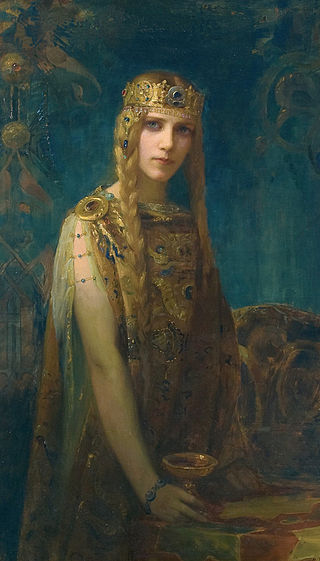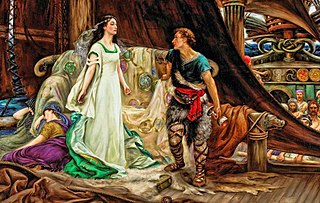Lyonesse is a kingdom which, according to legend, consisted of a long strand of land stretching from Land's End at the southwestern tip of Cornwall, England, to what is now the Isles of Scilly in the Celtic Sea portion of the Atlantic Ocean. It was considered lost after being swallowed by the ocean in a single night. The people of Lyonesse were said to live in fair towns, with over 140 churches, and work in fertile, low-lying plains. Lyonesse's most significant attraction was a castle-like cathedral that was presumably built on top of what is now the Seven Stones Reef between Land's End and the Isles of Scilly, some 18 miles (29 km) west of Land's End and 8 miles (13 km) north-east of the Isles of Scilly. It is sometimes spelled Lionesse.

Tristan, also known as Tristram, Tristyn or Tristain and similar names, is the folk hero of the legend of Tristan and Iseult. In the legend, his objective is escorting the Irish princess Iseult to wed Tristan's uncle, King Mark of Cornwall. Tristan and Iseult accidentally drink a love potion during the journey and fall in love, beginning an adulterous relationship that eventually leads to Tristan's banishment and death. The character's first recorded appearance is in retellings of British mythology from the 12th century by Thomas of Britain and Gottfried von Strassburg, and later in the Prose Tristan. He is featured in Arthurian legends, including the seminal text Le Morte d'Arthur, as a skilled knight and a friend of Lancelot. He is also a Knight of the Round Table.

The Knights of the Round Table are the legendary knights of the fellowship of King Arthur that first appeared in the Matter of Britain literature in the mid-12th century. The Knights are an order dedicated to ensuring the peace of Arthur's kingdom following an early warring period, entrusted in later years to undergo a mystical quest for the Holy Grail. The Round Table at which they meet is a symbol of the equality of its members, who range from sovereign royals to minor nobles.

Iseult, alternatively Isolde and other spellings, is the name of several characters in the legend of Tristan and Iseult. The most prominent is Iseult of Ireland, the wife of Mark of Cornwall and the lover of Tristan. Her mother, the queen of Ireland, is also named Iseult. The third is Iseult of the White Hands, the daughter of Hoel of Brittany and the sister of Kahedin.

Mark of Cornwall was a sixth-century King of Kernow (Cornwall), possibly identical with King Conomor. He is best known for his appearance in Arthurian legend as the uncle of Tristan and the husband of Iseult who engages with Tristan in a secret liaison, giving Mark the epithet "Cuckold King".

Tristan and Iseult, also known as Tristan and Isolde and other names, is a medieval chivalric romance told in numerous variations since the 12th century. Of disputed source, usually assumed to be primarily Celtic, the tale is a tragedy about the illicit love between the Cornish knight Tristan and the Irish princess Iseult in the days of King Arthur. It depicts Tristan's mission to escort Iseult from Ireland to marry his uncle, King Mark of Cornwall. On the journey, Tristan and Iseult ingest a love potion, instigating a forbidden love affair between them.

King Hoel, also known as Sir Howel, Saint Hywel and Hywel the Great, was a late 5th- and early 6th-century member of the ruling dynasty of Cornouaille. He may have ruled Cornouaille jointly after the restoration of his father, Budic II of Brittany, but he seems to have predeceased his father and left his young son, Tewdwr, as Budic's heir.
Felec or Felix was an obscure 5th- or 6th-century British saint active in Cornwall. The church of St Felicitas and St Piala's Church, Phillack near Hayle is dedicated to Saint Felec. Later generations mistook him for the female Saint Felicity of Rome.
Meliodas is a figure in Arthurian legend in the 12th-century Prose Tristan and subsequent accounts. In Thomas Malory's Le Morte d'Arthur, he is the second king of Lyonesse, son of Felec of Cornwall and vassal of King Mark. Meliodas' first wife, Elizabeth, who bore the hero Tristan, was Mark's sister, and his second wife was a daughter or sister of Hoel of Brittany. He is the eponymous protagonist of the romance Meliadus. The Italian variant Tristano Riccardiano calls him Felix (Felissi).
Brangaine is the handmaid and confidante of Iseult of Ireland in the Arthurian legend of Tristan and Iseult. She appears in most versions of the story.

Cornish mythology is the folk tradition and mythology of the Cornish people. It consists partly of folk traditions developed in Cornwall and partly of traditions developed by Britons elsewhere before the end of the first millennium, often shared with those of the Breton and Welsh peoples. Some of this contains remnants of the mythology of pre-Christian Britain.
King Arthur and King Cornwall is an English ballad surviving in fragmentary form in the 17th-century Percy Folio manuscript. An Arthurian story, it was collected by Francis James Child as Child Ballad 30. Unlike other Child Ballads, but like the Arthurian "The Boy and the Mantle" and "The Marriage of Sir Gawain", it is not a folk ballad but a professional minstrel's song. It is notable for containing the Green Knight, a character known from the medieval poems The Greene Knight and the more famous Sir Gawain and the Green Knight; he appears as "Bredbeddle", the character's name in The Greene Knight.
King Anguish of Ireland is a mythological character in the stories of King Arthur. His wife is Queen Lotta and he is the father of Iseult, and one of Arthur's early enemies in the chronicles. After Arthur defeats him he acknowledges Arthur's supremacy, but later becomes embroiled in a conflict with King Mark of Cornwall. After Mark refuses to pay Anguish seven years back pay for his vassalage, Anguish sends out Sir Marhaus to get the pay from him. The story is part of the saga of Tristan and Iseult.
Conomor, also known as Conomerus or Conomor the Cursed, was an early medieval ruler of Brittany. His name, which has the Welsh cognate Cynfawr, means "Great Dog", but could also indicate "Sea Dog" in early Brythonic. Conomor was notorious for his cruelty, becoming a legendary villain in Breton culture. He is widely regarded as one of the probable sources for the myth of Bluebeard and possibly also of Tristan's uncle King Mark of Cornwall. The wife-beating giant Cormoran may also retain a garbled folk memory of the same character.

The Tristan Quilt, sometimes called the Tristan and Isolde Quilt or the Guicciardini Quilt, is one of the earliest surviving quilts in the world. Depicting scenes from the story of Tristan and Isolde, an influential romance and tragedy, it was made in Sicily during the second half of the 14th century. There are at least two extant sections of the quilt, one of which is displayed in the Victoria and Albert Museum's Medieval and Renaissance Galleries, and the other in the Bargello in Florence. A third quilt, also depicting Tristan and Isolde, but not thought to be part of the V&A and Bargello examples, is held in private hands. The Tristan Quilts are the only known surviving intact examples of medieval quilts.
Lovespell is a 1981 fantasy romantic tragedy film featuring Richard Burton as King Mark of Cornwall. It was directed by Tom Donovan. It is based on the classic saga of Tristan and Isolde.

Tristan and Iseult is a children's novel by Rosemary Sutcliff and was first published in 1971. A re-telling of the ancient legend, it received the Boston-Globe Horn Book Award in 1972, and was runner-up for the 1972 Carnegie Medal.








